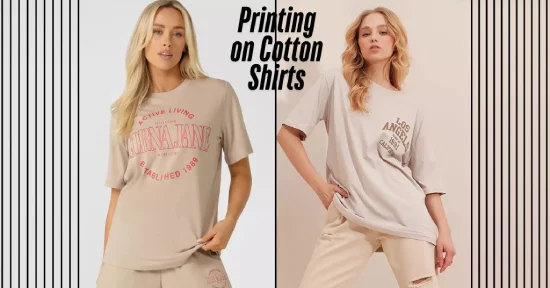Cotton dyeing and finishing involves various types of dyes, pigment applications, and finishes that play an important role in fabric production. Why Is a Cotton Shirt Used for Dyeing? This has the answer, its excellent absorbency, breathability and compatibility with such a broad range of dyes. The cotton fabric after to dye (PFD) process is ready for dyeing and finishing. In this article, we’ll lay the solid foundation of dyeing and finishing so that you’ll know the reason why a particular dye or production technique either uplifts or pains in the final fabric.
Dyeing and Pigments for Cotton
Dyeing
Piece dyeing and yarn dyeing are the most common processes used to color cotton. Why is a cotton shirt used for the dyeing? The simple answer is that cotton absorbs dye easily and presents considerable colour ability. In piece dyeing, which is used mainly for solid-colored fabrics, a dry piece of cloth is passed through a hot dye solution trough across its full width.
The fabric then passes between padded rollers that compress the color evenly and remove excess liquid. This basic method is then varied in which a coil of fabric, like a rope, is run through a dye vat or tub on a reel that is then passed in and out of the vat.
Gingham checks and plaids, woven stripes and other special effects are produced by yarn dyeing prior to we Avery or knit the fabric. For example, blue-dyed warp yarns are combined with white filling yarns in denim.
One of the most common methods of yarn dyeing is package dyeing. In this system, the yarn is wound onto perforated cylinders or packages and placed on vertical spindles in a circular dyeing machine. The dye solution is forced alternately from the outside to the inside and from the inside to the outside of the packages under pressure. More and more painting processes use computers to match and formulate colours quickly and precisely.
Reactive Dyes
Cotton garments can best be dyed using reactive dyes because of the exceptional colour retention and wash fastness of reactive dyes. Unlike other types of dyes that tend to fade over time and the dyes can also run in your clothing, reactive dyes are bonded chemically to the fibres of cotton, making the colour shiny and enduring even through many washes.
This is what makes them very popular in the textile industry as a source of producing quality, long life fabrics. Reactive dyes, however, might not be the best choice if you want to actually get a wintry fading over time, and get a washed vintage look that way.
This superior fading resistance ensures that reactive dyed garments will maintain the hue they had when they were new for a long time — it is hard to get the look you want with worn-in. For instance, some people want a softer, more aged appearance, and so might choose other dyeing methods that produce gradual colour loss and distressing over time.

Direct Dyes
Because colour light fastness is well developed for direct dyes, they are commonly selected for their appreciable light fastness, i.e., a fabric that necessitates long-lasting colour. For a start, they have a unique tendency to fade as time goes on, this then results in a desired vintage or worn-in effect.
As direct dyes have this unique property of fading, they have become a preferred option in the fashion industry in order to achieve a soft aged look in garments. Dyeing cotton fabrics, including casual wear, denim, t-shirts, home textiles such as draperies and upholstery, are commonly used.
Due to their ability to bind directly to cellulose fibers without a mordant, they are also convenient and cheap to large scale textile production. Moreover, they have very simple process for application and are of different types of colours, so they are a useful choice by designers and manufacturers who want to make both very contrasting & gently faded effects.
Vat Dyes
They are well known for their outstanding color fastness, especially to light, an important property for outdoor textile use. Unlike other dye types, these perform well both in retaining vibrancy and fading resistance under harsh environmental conditions on natural fibres, such as cotton and rayon.
This durability however makes vat dyes the preference for projects relying on long-term color so as to avoid redeye of the vat used. Moreover, most VAT dyes are manufactured in continuous dye range to provide constant, high-quality work on high-volume production runs.
In addition, this method supports manufacturers not only in the sense of enhancement in efficiency, but it also cuts down on waste, which is a wholly economical strategy. Since vat dyeing for bulk quantities is highly profitable and also promises higher production output compared to other methods of dyeing, businesses are recommended to invest in vat dyeing for bulk quantities for the superior performance that these dyes are known to offer.

Pigments
Pigments have superior color-light fastness. These versatile options can be used with cotton and all blends. Why Is a Cotton Shirt Used for Dyeing? Cotton being a natural fiber structure has the good adherence of pigments which is what makes it a better choice for the fabric printing applications. Pigments can be applied to fabric using a variety of methods, including the traditional pad batch system, which pads the pigments on both sides. Pigments can also be used on rotary and flatbed printers and digital pigment printers.
Fact: The majority of fabric printing today is using pigments overdyes.
Now, you may be asking what the difference is between cotton dyes and pigments.
Aside from the chemical differences, the main difference between cotton dyes and pigments is that dyes completely penetrate the fabric, while pigments remain on the surface of the fabric.

Printing
Printing colored designs on cotton fabric is similar to printing on paper. Long runs of the same fabric design are produced on a roller press operating at speeds of 50 to 100 yards per minute. Up to 10 different colors can be printed in a single continuous operation.
A typical press consists of a large compound cushioned drum, or cylinder; and the grips located about its circumference, a series of copper rollers, each with its own dye vat and a doctor blade that scrapes off excess dye. The number of rollers varies with the fabric design, as each color in the design is etched onto a separate roller.
As the fabric moves under tremendous pressure between the rotating drum and rollers, it picks up color from each roller’s etched area in turn. The printed fabric is immediately dried and moved to an oven that sets the dye.

Finishing
As the name suggests, finishing is the final step in fabric production. Textiles can be finished in hundreds of ways and many of the finishes applied to them can be done in many different ways.
Cotton fabrics are finished in more ways than any other type of fabric. Cotton fabric can change the way it looks and feels as some finishes do, and some others add such properties as durable press, water repellency, flame resistance, shrinkage control and many more.
Several different finishes can be applied to a single fabric. Various cotton finishes can be given to the fabric that alters the handle, improves the durability and even repel water. In later articles, we will go into some detail about some of the most important finishes. Our focus for now is on one cotton finish, shrinkage. For now, we’ll focus on one cotton finish: shrinkage. Suffice it to say, preventing shrinkage is extremely important.
Preventing Shrinkage
Mechanical and chemical processes are all employed to get away with fabric shrinkage. Among these methods are chemical treatments of the fabric to change its structure, or physical methods of stabilizing the fibers.
To reduce shrinkage with the fewest possible health effects, TVF contributes to mechanical solutions like tumbling and permanent press. Gently agitating the fabric before washing helps pre relax fibers and reduce the possibilities of further shrinkage upon washing. This same heat and (sometimes) pressure is used in permanent press treatments to set the fabric’s form permanently, such that it retains its original size.
Through these mechanical processes, TVF is able to focus on minimization of shrinkage without giving up fabric integrity or user safety.
It is important to prevent shrinkage as it can cause severe damage to the turned part.
No one wants to buy their clothing that shrinks after the first wear. When the water and heat come nearer, the cotton fabric contracts naturally and if the garment has fitted design then it is more likely to warp or lose the shape used.
Customers want to be sure that their shirts are not too small or too big, and are of the best quality. Unscheduled shrinkage ruins the customer’s experience and can even prompt them to post a negative review about your brand.
In addition, the frequent return as a result of sizing problems tends to result in costly returns to retailers and impairing a brand’s reputation. Why Is a Cotton Shirt Used for Dyeing? But besides its durability, preventing shrinkage is equally important to keep its quality and longevity.
Conclusion
Cotton’s versatility and its unique properties, as well as those of the other fibres, make it an ideal material for dyeing and finishing many different processes. Cotton has remains a top contender in the textile industry for all the excellent absorbency and breathability that makes cotton perfect for dyeing, its durability and the ability to hold colour. Certainly cotton can be treated with reactive dyes, direct dyes, vat dyes or pigments, to produce rich, long lasting colours.
Also, it is important to be knowledgeable on the dyeing and finishing processes, including piece dyeing, yarn dyeing and fabric printing before cotton fabrics with high quality in the industrial are produced and meet the consumer expectations. Shrinkage prevention, aesthetic appeal and durability can be treated to fabrics with the right methods. At a point, This is more like relaxed and sophisticated fashion of the dark academic fashion.
FAQ
It is for these reasons that it is cotton, that is so good at absorbing and allowing breathability and mixing with various dyes. Cotton possesses these qualities that allow the cotton to hold bright and flat colours, which makes it very suitable for material production.
Pigments sit on top of the fabric; dyes enter the cotton fibers and are chemically bound to them. The advantage of dyes is the greater intensity of colour although pigments are used where superior light fastness is desired, as in fabric printing.
Piece dyeing of the fabric after weaving or yarn dyeing of the yarn before it is woven or knitted are the two major ways to dye cotton. Other methods are available to produce different colours and designs.
In order to prevent shrinkage, the size, shape and quality of cotton garments are best prevented. Negative customer feedback, rushed customer dissatisfaction and negative PR, and expensive returns can be the results of shrinking.







